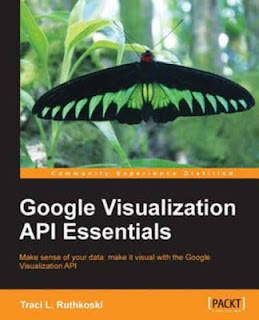Google Visualization API Essentials
Download
Visualization is a key component of analytics in both public and private
organizations. The ability to view and even manipulate data visually is quickly
becoming commonplace. Chart Tools, also known as the Visualization API, are
powerful tools with low barriers to entry and are capable of impressive results with
very little development time. Learning the Google Visualization API is also a helpful
introduction to the larger collection of Google APIs.
What this book covers
Chapter 1, Tools and Setup, shows an overview of the various tools that can be used
to create visualizations, from beginner to advanced levels. The purpose here is to
explain the multiple approaches of using the API through different tools.
Chapter 2, Anatomy of a Visualization, describes the common high-level architecture
that covers all methods of working with the Visualization API. This chapter also
discusses the integrated nature of using the Visualization, Maps, and Fusion
Tools APIs.
Chapter 3, Spreadsheet Charts and Fusion Tables, discusses becoming familiar with
Fusion Tables and Google Spreadsheets user interfaces for chart creation and offers
an easy to understand foundation from which advanced examples can be built.
Chapter 4, Basic Charts, dives deeper into the coding methods for the Visualization
API. The examples are illustrated from beginner to advanced levels through
examining each in Spreadsheets, Fusion Tables, and finally the code.
Chapter 5, Formatting Charts, shows formatting and style options for both tables
and charts.
Chapter 6, Data Manipulation and Sources, describes methods of data sourcing
for all visualization approaches. Techniques for querying and displaying data
are also discussed.
Chapter 7, Dashboards, Controls, and Events, discusses user dashboards and controls.
Dashboards and controls allow for user interactivity with the visualization.
Chapter 8, Advanced Charts, covers advanced topics in visualization with Google tools.
Also included is further instruction on the use of Fusion Tables specifically for map
data generation. The last section of the chapter will give a brief overview on how to
build a fully custom virtualization.
Chapter 9, Publishing Options, discusses how, similar to multiple development options
for Google Visualization, there are also multiple ways to share charts with others.
This chapter presents common methods for publishing and sharing visualizations.
What you need for this book
Very little is required to get started. At the bare minimum, a Google account
(free) and some experience working with HTML is expected. For advanced topics,
knowledge of the basic programming concepts as well as some JavaScript experience
is ideal.
The Google Visualization API does not require software to be installed on
your computer. It is possible to perform all the development through an
HTML5/SVG-capable web browser. However, for developers already
familiar with common development environments such as Eclipse, it is
also possible to develop for the Visualization API from these applications
Who this book is for
This book will show you how to create web-ready data visualizations using
Google's infrastructure. From casual Spreadsheets users to web developers,
this book provides readers with both novice and advanced examples. Anyone
with a need to dynamically visualize data on a website will benefit from reading
this book.
Home Api Development Google Visualization API Essentials

